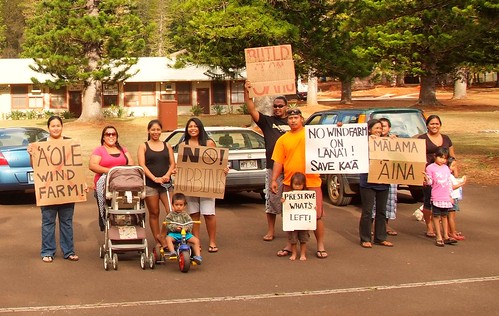Lanai resists plans for 200 wind turbines, each taller than the First Hawaiian Bank Building
HONOLULU—Plans by the Castle and Cooke development company to build a 400 MW industrial wind power plant on Lanai has resulted in heated contention with the island’s residents. A group called Friends of Lanai said the wind power plant will permanently alter, possibly destroy, and disfigure one-quarter of the island.
Tensions between developers and opponents regarding the proposed windmill farm comprised the majority of the information meeting held last week at the Hawaii State Capitol.
The State Senate committees on Energy and the Environment and Commerce and Consumer protection convened an informational briefing last Tuesday to examine plans put forward by Hawaiian Electric Company (HECO) and Castle and Cooke. The proposed windmill farm on Lanai would supply 15 percent of Oahu’s energy needs. First Wind would be contracted to build as many as 200 windmills. Each of them would rise to over 400 feet—as tall as Downtown Honolulu’s First Hawaiian Bank building. Underwater cables would be installed to transfer energy from the former pineapple-producing island to residents of East Oahu.

HECO is pushing for the project in an effort to comply with a 2009 State law mandating that, by 2030, 40 percent of Hawaii’s electricity be derived from renewable sources. Still in its planning stages, there is no set date for groundbreaking, and environmental and cultural impact studies have yet to be released.
Representatives from both HECO and Castle and Cooke emphasized their recent commitment to a benefits package for Lanai to be included in their power purchase agreement. Some of the perks include reducing electricity rates for the island (some of the highest in the nation), a community benefits fund with proceeds coming from one percent of the wind farm’s gross revenue, and continued access to fishing and hunting grounds near the site of the proposed windmills, and the opportunity for residents to buy their homes fee simple. Castle and Cooke owns 98 percent of the land on Lanai.
“Our role is to make sure the community is treated appropriately,” said Robbie Alm, executive vice president for public affairs at HECO.
Harry Saunders, president of Castle and Cooke, notes that other benefits include construction jobs for Lanai residents, improved infrastructure on the island, and an estimated $7 million a year in taxes for the State over a 20-year period.
But representatives from the various groups based in Lanai voiced their concerns, if not their outright opposition to the plan.
“Before looking at the benefits, they should identify the costs first,” said Butch Gima, vice president with the non-profit Lanaians for Sensible Growth, which has been outspoken against the wind farm. Gima said the organization has asked the developers for a detailed list of the numerous impacts, for audio recordings of the wind turbines in action, and for three-dimensional renderings of the wind farm—none have yet been produced. “They have refused to do that,” Gima said.
Robin Kaye, a member of Friends of Lanai, said Hawaii tax payers would bear the brunt of the costs. The State is expected to pay for the $1 billion underwater cable installation, while Castle & Cooke would earn as much as $3 billion over the project’s 20–year life expectancy.
Kaye also noted the environmental impacts on endangered birds and the humpback whales, the ruined view, and the disruption of the social fabric from the incoming workforce who will manage the windmills.
“Lanai will never be the same,” Kaye said.
Another member, Martha Evans, noted that Lanai always takes the backseat to the other islands, saying that the island will be used like an industrial power plant for Oahu. She said usurping a quarter of the island to provide 10 percent of our energy needs is irresponsible land management.
“I support clean energy,” she said, “but I do not support this mammoth abuse of our aina.”
In response, Saunders reiterated what he said earlier in his presentation—that cultural and environmental concerns would be addressed in the upcoming Environmental Impact Statement.

Politicians also weighed in with their concerns.
“How can we be confident that these [benefits] will actually materialize?” said Sen. Rosalyn Baker, D-Honokohau-Makena, chairwoman of the Committee on Commerce and Consumer Protection.
Baker recalled a past instance where Castle and Cooke made similar promises regarding fee-simple purchases of land on the island.
“They never ended up being able to buy anything,” she said. “The company doesn’t have, in my view, a really good track record.”
Saunders, in response, didn’t agree with Baker’s appraisal of the company’s track record, noting that they employ hundreds of people on the island. He also said that HECO and Castle and Cooke are bringing out this benefits package early so that it can be put into the power purchasing agreement and need the government’s help in subdividing the properties so they are sellable.
“We would be better off selling,” Saunders said.
Baker asked for a contract with more “teeth.”
“A power purchase agreement wouldn’t be monitorable or enforceable,” Baker said.
One senator acknowledged that all invested parties should have empathy and be willing to compromise.
“We’re all in this together. Oahu really has to understand that Lanai and Molokai are giving up a lot,” said Sen. Kalani English (D), vice chairman for the Committee on Energy and the Environment. “Also, the people on Lanai and Molokai need to understand they’re being called upon by the rest of the State to help us find an energy pathway out of oil.”
Related Story:

Island battery: Is supplying 10 percent of Oahu’s power worth destroying Lanai?